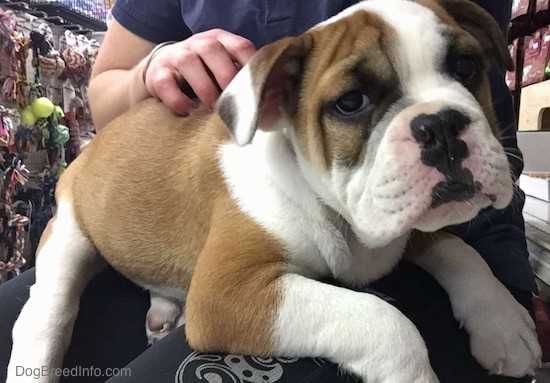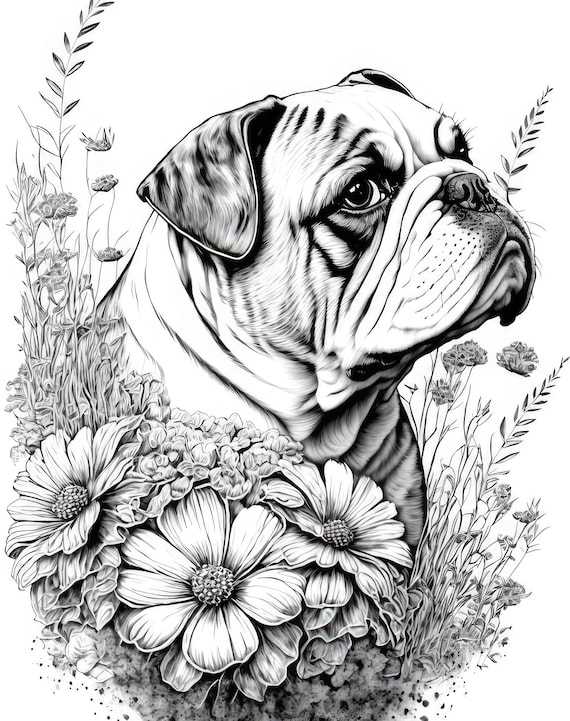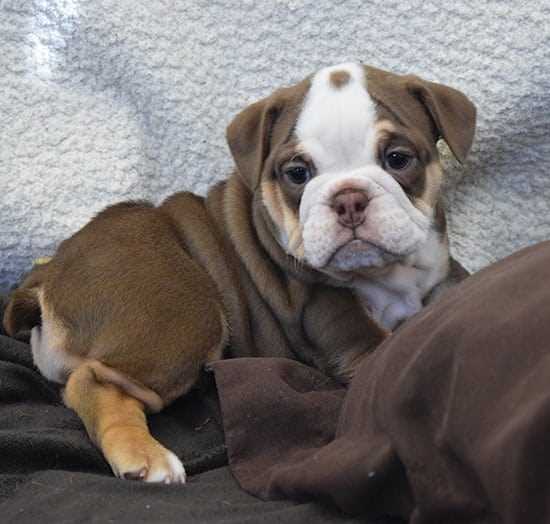
The English Bulldog is a beloved breed known for its distinctive appearance and charming personality. One of the most fascinating aspects of this breed is its coat color. English Bulldogs come in a variety of colors and patterns, each with its own unique characteristics.
One of the most common coat colors seen in English Bulldogs is the classic brindle. This color pattern consists of a base color, usually fawn or white, with dark stripes that can range from black to shades of brown. The brindle coat gives these Bulldogs a striking and eye-catching appearance, making them stand out from the crowd.
Another popular coat color in English Bulldogs is white. While some may think of white as a plain or simple color, it actually adds a touch of elegance and sophistication to the breed. White Bulldogs often have patches or spots of color on their bodies, such as brindle or fawn, creating a beautiful contrast that is truly stunning.
In addition to brindle and white, English Bulldogs can also come in other coat colors such as fawn, red, and pied. Fawn Bulldogs have a light tan or beige color, while red Bulldogs have a deeper and richer shade of red. Pied Bulldogs have patches of color on a white background, creating a unique and eye-catching pattern.
When it comes to coat color, English Bulldogs offer a wide range of options, each with its own distinct beauty. Whether you prefer the classic brindle, the elegance of white, or the uniqueness of pied, there is a coat color that will surely capture your heart. So, take a closer look at the coat color of the English Bulldog breed and discover the beauty and charm that these dogs have to offer.
The Standard Colors

The English Bulldog breed is known for its variety of coat colors. However, there are certain colors that are considered standard for this breed. These standard colors are recognized by kennel clubs and are commonly seen in English Bulldogs.
1. Fawn: Fawn is one of the most common colors seen in English Bulldogs. It ranges from a light, pale tan to a deep, reddish-brown. Fawn Bulldogs may have a mask or be maskless.
2. Brindle: Brindle Bulldogs have a coat pattern that consists of dark streaks or stripes on a lighter background color. The stripes can be black, brown, or a combination of both. Brindle Bulldogs may also have a mask or be maskless.
3. Red: Red Bulldogs have a solid red coat without any other markings. The shade of red can vary from a light, orangey-red to a deep, mahogany red.
4. White: White Bulldogs have a pure white coat without any other markings. They may have a few small patches of color on their body, but overall, they are predominantly white.
These standard colors are considered desirable in the English Bulldog breed and are often seen in show dogs. However, it’s important to note that English Bulldogs can also come in non-standard colors, which will be discussed in the next section.
Fawn

The fawn coat color is one of the standard colors for English Bulldogs. It is a light tan or beige color that can range from a pale cream to a darker shade of brown. Fawn Bulldogs have a solid coat color without any markings or patterns.
One of the distinguishing features of fawn Bulldogs is their black facial mask. This mask covers their muzzle and extends up to their eyes, giving them a unique and adorable look. The mask can vary in intensity, with some Bulldogs having a darker mask than others.
Fawn Bulldogs often have a white chest and may have some white markings on their paws or belly. These white markings are considered acceptable according to the breed standard.
When it comes to genetics, fawn Bulldogs carry the “ay” allele, which is responsible for the fawn coat color. This allele dilutes the black pigment in the coat, resulting in the light tan or beige color.
Fawn Bulldogs are highly sought after and are popular among Bulldog enthusiasts. Their unique coat color, combined with their charming personality, makes them a favorite choice for many dog lovers.
Health Considerations

While fawn Bulldogs are beautiful and beloved by many, it’s important to note that they may be more prone to certain health issues. Like all Bulldogs, they can suffer from breathing problems due to their brachycephalic (short-nosed) structure. Fawn Bulldogs may also be susceptible to skin allergies and eye problems.
It’s crucial for owners of fawn Bulldogs to provide proper care and attention to their health needs. Regular veterinary check-ups, a balanced diet, and a suitable exercise routine are essential for keeping them healthy and happy.
Conclusion

Fawn Bulldogs are a stunning breed with their light tan or beige coat color and distinctive black facial mask. They are highly sought after by Bulldog enthusiasts and make wonderful companions. However, it’s important to be aware of their potential health issues and provide them with the care they need to thrive.
| Coat Color | Genetic Explanation |
|---|---|
| Fawn | “ay” allele dilutes black pigment |
Brindle

The brindle coat color is another common color seen in English Bulldogs. It is characterized by a mixture of dark and light stripes on a lighter background color. The stripes can be black, brown, or a combination of both. The background color can range from light tan to a darker shade of brown.
Brindle English Bulldogs can have different patterns of stripes, including a tiger stripe pattern, where the stripes are more pronounced and resemble the stripes of a tiger. Another pattern is the reverse brindle, where the background color is darker and the stripes are lighter.
Brindle English Bulldogs are highly sought after by many dog enthusiasts due to their unique and striking coat color. The brindle pattern adds a touch of elegance and sophistication to the breed.
In addition to the aesthetic appeal, the brindle coat color is also associated with certain health benefits. It has been observed that brindle English Bulldogs have a lower risk of developing certain genetic disorders compared to other coat colors.
It is important to note that the brindle coat color is not considered a standard color according to the breed standards set by kennel clubs. However, it is still widely recognized and accepted by English Bulldog enthusiasts.
Overall, the brindle coat color is a beautiful and unique characteristic of the English Bulldog breed. Whether you prefer the classic tiger stripe pattern or the reverse brindle, owning a brindle English Bulldog is sure to make a statement.
Red

The red coat color is one of the standard colors of the English Bulldog breed. Bulldogs with a red coat have a rich, deep red color that is often described as mahogany or chestnut. This color is caused by the presence of the eumelanin pigment, which gives the coat its reddish hue.
Red Bulldogs typically have a solid red coat, although some may have small patches of white on their chest or other areas of the body. The intensity of the red color can vary from dog to dog, with some Bulldogs having a darker shade of red while others have a lighter, more coppery tone.
When it comes to the genetics of the red coat color in Bulldogs, it is a dominant trait. This means that if a Bulldog carries the gene for red, it will have a red coat. However, it is important to note that not all Bulldogs with a red coat are purebred. Some mixed breed Bulldogs or Bulldogs with unknown pedigrees may also have a red coat.
Red Coat Health Considerations

While the red coat color is aesthetically pleasing, it is important to note that Bulldogs with a red coat may be more prone to certain health issues. This is because the gene responsible for the red coat color is often linked to other genetic traits that can increase the risk of certain health conditions.
For example, Bulldogs with a red coat may be more likely to have skin allergies or sensitivities. They may also be more prone to certain eye conditions, such as cherry eye or entropion. Additionally, Bulldogs with a red coat may be more susceptible to heat exhaustion or heat stroke due to the darker color of their coat.
Caring for a Red Bulldog

If you have a red Bulldog, it is important to take extra care to keep their coat and skin healthy. Regular grooming is essential to prevent matting and to keep the coat clean. It is also important to provide proper nutrition and regular veterinary care to address any potential health issues.
When it comes to sun exposure, Bulldogs with a red coat may be more prone to sunburn. It is important to limit their time in direct sunlight, especially during the hottest parts of the day. Applying pet-safe sunscreen to exposed areas, such as the nose and ears, can also help protect their skin from sun damage.
| Pros | Cons |
|---|---|
| Rich, deep red color | Potential health issues |
| Unique and eye-catching | Increased risk of sunburn |
| Can have small patches of white | Requires regular grooming |
White

The white coat color is one of the recognized standard colors for English Bulldogs. It is a popular and sought-after color among breeders and enthusiasts. White Bulldogs have a solid white coat without any markings or patches of other colors.
White Bulldogs often have pink noses and light-colored eyes, which add to their unique and charming appearance. Their coat is usually short and smooth, giving them a sleek and clean look. The white color can vary in shade, ranging from pure white to a slightly off-white or cream color.
White Bulldogs are known for their friendly and gentle temperament. They are often described as being calm, affectionate, and good-natured. They make excellent family pets and are generally good with children and other animals.
However, it is important to note that white Bulldogs are more prone to certain health issues compared to Bulldogs with other coat colors. They may be more susceptible to skin problems, allergies, and sunburn due to their lack of pigment in the skin. It is important for owners of white Bulldogs to take extra care of their skin and protect them from excessive sun exposure.
Non-Standard Colors

In addition to the standard colors of the English Bulldog breed, there are also non-standard colors that can be found in this unique and beloved breed. These non-standard colors may not conform to the breed standard, but they are still recognized and cherished by many Bulldog enthusiasts.
One of the non-standard colors that can be seen in English Bulldogs is the black color. Bulldogs with a black coat are quite rare, but they are highly sought after by collectors and enthusiasts. The black color can range from a solid black to a black brindle, where the black is mixed with another color such as fawn or white.
Another non-standard color that can be found in English Bulldogs is the chocolate color. Bulldogs with a chocolate coat have a rich brown color that can vary in shade. This color is often seen in combination with white markings, which adds to the unique and striking appearance of these Bulldogs.
Merle is another non-standard color that can be seen in English Bulldogs. Bulldogs with a merle coat have a mottled pattern with patches of color on a lighter background. The merle pattern can come in various colors, such as blue merle, chocolate merle, or fawn merle. Bulldogs with a merle coat are known for their distinctive and eye-catching appearance.
Lastly, there are also English Bulldogs with a lilac coat, which is another non-standard color. Bulldogs with a lilac coat have a unique and rare color that is a dilution of the chocolate color. This color is often described as a pale lavender or grayish color, and it can be seen in combination with white markings.
While these non-standard colors may not be considered “traditional” for the English Bulldog breed, they are still loved and appreciated by many Bulldog enthusiasts. These unique colors add to the diversity and beauty of the breed, and they showcase the individuality of each Bulldog.
| Non-Standard Colors | Description |
|---|---|
| Black | Rare solid black or black brindle coat |
| Chocolate | Rich brown coat often seen with white markings |
| Merle | Mottled pattern with patches of color on a lighter background |
| Lilac | Pale lavender or grayish coat, often with white markings |
Blue

The blue coloration in English Bulldogs is a result of a dilution gene that affects the pigmentation of their coat. This dilution gene causes the black pigments in the coat to appear as a blue-gray color. Blue Bulldogs have a unique and striking appearance that sets them apart from other coat colors.
Blue Bulldogs can come in various shades of blue, ranging from a light gray-blue to a darker steel blue. Some may even have a bluish tint to their coat. The intensity of the blue color can vary depending on the individual dog.
It is important to note that blue Bulldogs are not recognized as a standard color by kennel clubs and breed standards. However, they have gained popularity among enthusiasts and are often sought after as unique and rare pets.
While blue Bulldogs may have a distinct appearance, it is essential to consider their health. The dilution gene that causes the blue coloration is also associated with certain health issues. Blue Bulldogs may be more prone to skin problems, allergies, and coat issues compared to other coat colors.
When considering a blue Bulldog as a pet, it is crucial to find a reputable breeder who prioritizes the health and well-being of their dogs. Responsible breeders will conduct health screenings and genetic testing to ensure that their blue Bulldogs are as healthy as possible.

Tyler Newsom, a canine enthusiast, is passionate about bulldogs and their coat care. With years of experience and dedication, he shares his expertise to help bulldog owners maintain their beloved pets’ fur health and vitality through practical tips and advice.
